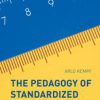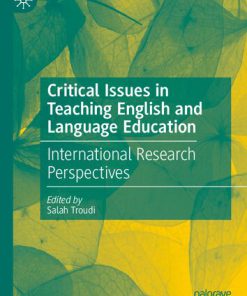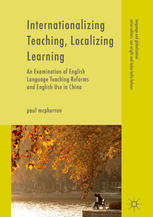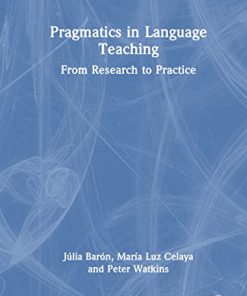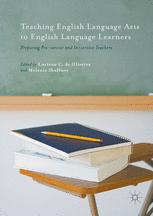English Language Teaching Today Linking Theory and Practice 1st Edition by Willy Renandya,Handoyo Puji Widodo 3319388320 9783319388328
$50.00 Original price was: $50.00.$25.00Current price is: $25.00.
English Language Teaching Today Linking Theory and Practice 1st Edition by Willy Renandya,Handoyo Puji Widodo – Ebook PDF Instant Download/Delivery:3319388320,9783319388328
Full download English Language Teaching Today Linking Theory and Practice 1st Edition after payment
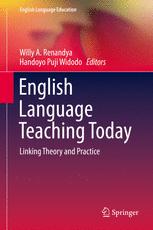
Product details:
ISBN 10:3319388320
ISBN 13:9783319388328
Author:Willy Renandya,Handoyo Puji Widodo
English Language Teaching Today: Linking Theory and Practice provides an up-to-date account of current principles and practices for teaching English in the world today. The chapters, written by internationally recognized language teacher educators and TESOL specialists, introduce the reader to key language skill areas (i.e., listening, speaking, reading, writing, pronunciation, grammar and vocabulary) and explain how each skill area can be taught in a principled manner in diverse language learning contexts. Throughout the book, the link between theory and practice is explicitly highlighted and exemplified.
This reader-friendly book is suitable for undergraduate and graduate students enrolled in TESOL and other second language education programmes as well as for TESOL professionals who wish to stay current with recent developments in ELT.
English Language Teaching Today Linking Theory and Practice 1st Table of contents:
Part I: Theories, Research, and Principles
English Language Teaching Today: An Introduction
1 Background
2 Aims of the Book
3 Principles and Practices
4 Organization of the Book
5 Conclusion
References
Student-Centred Learning in ELT
1 Introduction
2 Meanings and Elements of Student Centred Learning
3 Roots of Student Centred Learning
4 Linking Ten Elements of SCL with Second Language Pedagogy
4.1 Students and Teachers as Co-learners
4.2 Student-Student Interaction
4.3 Learner Autonomy
4.4 Focus on Meaning
4.5 Curricular Integration
4.6 Diversity
4.7 Thinking Skills
4.8 Alternative Assessment
4.9 Learning Climate
4.10 Motivation
5 Conclusion
References
Using Local Languages in English Language Classrooms
1 Introduction
2 Why is the Use of Local Languages Not Integrated into Mainstream TESOL Theory and Practice?
3 Hegemonic Ideologies About Language, Language Use, and Language Learning and Teaching
3.1 Language as Stable, Standardized, Monolithic, Discrete Entities Rather Than as Fluid Resource
3.2 Language Learning as a Zero-Sum Game
3.3 Language as a Commodified and Standardized Set of Knowledge Items and Skills That Can be B
4 Benefits of Integrating Local Languages in English Language Classes
5 How and When Should Local Languages be Used in English Language Classes?
6 The Multimodalities/Entextualization Cycle (MEC)
7 Concluding Remarks
Notes
References
Applying Language Learning Principles to Coursebooks
1 Introduction
2 Course Book Publication
3 Teachers and Coursebooks
4 Principles
4.1 The Principle of the Four Strands
4.2 The Fluency Principle
4.3 The Frequency Principle
4.4 The Interference Principle
4.5 Other Principles
5 Concluding Remarks
References
Current Issues in the Development of Materials for Learners of English as an International La
1 Introduction
2 The Needs and Wants of Learners of English as a Lingua Franca
2.1 The Needs
2.2 The Wants
3 Ways in Which Materials Can Cater for the Needs and Wants of Users of English as a Lingua
3.1 The Use of Authentic Texts
3.2 The Use of Authentic Tasks
3.3 The Use of Spoken Interactions Between Non-native Speakers
3.4 Learner Unstructured Interaction
3.5 Pragmatic Awareness Activities
3.6 The Use of Written Texts Produced by Non-native Speakers for Global Readership
3.7 The ‘Teaching’ of Capabilities which are Particularly Important in Achieving Successful Co
3.8 The ‘Teaching’ of Language Items and Features Important for International Communication
3.9 The Development of Inter-Cultural Competence
4 Conclusion
References
Assessment in ELT: Theoretical Options and Sound Pedagogical Choices
1 Introduction
2 Assessment Options
3 Pedagogical Implications
3.1 How Do Content Issues Compare for the Assessment Types?
3.2 How Do Logistical Issues Compare for the Assessment Types?
3.3 How Do Scoring Issues Compare for the Assessment Types?
3.4 How Do Communicative Characteristics Compare for the Assessment Types?
4 Conclusions
Note
Appendix 1: Advantage of the Four Categories and 12 Assessment Types
References
Does Writing Promote Reflective Practice?
1 Introduction
2 What Is Reflective Practice?
3 Teaching Journals
4 The Study
5 Procedures
6 Findings
6.1 T1’s Written Reflections
6.2 T2’s Written Reflections
6.3 T3’s Written Reflections
7 Reflecting and Writing a Teaching Journal: Unease?
8 Using Teaching Journals Effectively
9 Conclusion
References
Part II: Pedagogical Practices
Extensive Reading and Listening in the L2 Classroom
1 Introduction
2 Extensive Reading
2.1 What is ER?
2.2 What are the Language Learning Benefits of ER?
3 Extensive Listening
3.1 What is EL?
3.2 What Are the Language Learning Benefits of EL?
4 Principles for Implementing ER and EL
5 Problems and Concerns
6 Conclusion
References
Teaching L2 Listening: In and Outside the Classroom
1 Introduction: The Importance of Developing L2 Listening Skills
2 The Features of Spoken Language
3 Factors Affecting L2 Comprehension
3.1 External Factors: The Opportunities of Input and Speaker Factors
3.2 Medium Factors: Text, Task, and Context
3.3 Internal Factors: Language Proficiency and Background Knowledge
4 Format of a Well-Designed Listening Lesson
4.1 The Pre-listening Phase
4.2 The While-Listening Phase
4.3 The Post-Listening Phase
4.4 A Word of Caution
5 Suggested Approaches to Listening Practice After Teaching
5.1 Narrow Listening
5.2 Repeated Listening
5.3 Simultaneous Reading and Listening
6 Conclusion
References
Teaching Reading and Viewing to L2 Learners
1 Introduction
2 Views on Reading and Viewing
2.1 Top-Down and Bottom-Up Models
2.2 Interactive Models
2.3 Use of Reading/Viewing Strategies
2.4 Sociocultural Perspectives on Reading and Viewing
3 Factors Affecting Reading and Viewing Success
4 Effective Instruction in Reading and Viewing
5 Research-Informed Pedagogical Recommendations
6 Developing Metacognitively-Strong Readers and Viewers
7 A Proposed Pedagogical Cycle for Teaching Reading and Viewing
8 Teaching Reading and Viewing in the Classroom
9 Conclusion
References
Teaching Speaking
1 Introduction
2 Second Language Speaking
2.1 Speaking Competence
2.1.1 Enabling Skills
Pronunciation Skills
Speech Function Skills
Interaction Management Skills
Discourse Organisation Skills
2.1.2 Communication Strategies
2.1.3 Language and Discourse Knowledge
3 Processes in Speech Production
3.1 Directions of Speech Processing
3.2 Metacognitive Processes
3.3 L2 Speaking Performance
4 Speaking Tasks
5 Enhancing Second Language Speaking Performance
5.1 Pre-task Planning
5.2 Task Repetition
5.3 Metacognition Enhancement
6 A Comprehensive and Holistic Approach
7 Conclusion
References
Teaching English for Intercultural Spoken Communication
1 Introduction
2 What is Intercultural Language Learning?
3 Why Focus on the ‘Intercultural?’
4 A Set of Principles to Guide the Teaching of Intercultural Spoken Communication
4.1 Background
4.2 Principle 1. Mine the Social Context of Learning
4.3 Principle 2. Focus on Intercultural Learning Objectives
4.3.1 Foster and Affirm Intercultural Learning Achievements in Tandem with Linguistic and Commun
4.4 Principle 3. Adopt Intercultural Classroom Practices
4.4.1 Provide Opportunities for Learners to Engage with Culture in and Around Language From th
4.4.2 Principles 3(b): Provide Opportunities for Learners to Interact and Communicate in the La
4.4.3 Principle 3(c): Provide Opportunities for Learners to Explore, Reflect on, Compare and Conn
4.4.4 Principle 3(d): Provide Opportunities for Learners to put Learning Into Practice Beyond th
5 Conclusions
Notes
Appendix: The Six Principles for Intercultural Communicative Language Teaching (iCLT) (Newton et
References
Teaching Writing
1 Introduction
2 Second Language Writing
3 Writing Competence
3.1 Paraphrase and Direct Quotation
3.2 Lexical Variety
3.3 Passive Voice
3.4 Thinking Processes: Information Focused Approach vs. Knowledge Transformation Approach
3.5 Structuring and Developing Argument at the Macro and Micro Levels
4 Writing Process
5 The Use of Technologies to Enhance the Teaching of Writing
6 Enhancing Second Language Writing Performance
6.1 Using a Socio-Cognitive Approach to Writing
6.2 Understanding Features That Make a Text Coherent
6.3 Adopting Good Editing Strategies
7 Pedagogical Principles of the Socio-Cognitive Approach to Academic Writing
8 Conclusion
References
Teaching Academic Writing in Context
1 Introduction
2 Literature Review
3 Teaching Academic Writing in Context
3.1 Teaching “EAP: Academic Writing” (in Beijing)
3.2 Teaching “EIL: Research Thesis Project” (in Hong Kong)
3.3 Teaching “EIL: Writing Across Cultures” (in Melbourne)
4 Pedagogical Principles for Teaching English Academic Writing
5 Conclusion
References
Teaching English Grammar in Asian Contexts
1 Introduction
2 The English Mood
2.1 The Proposed Teaching Strategy
2.1.1 Using Text as Context of Use
2.1.2 Reader-Response Approach
2.2 The Absence of Finite
2.2.1 A Teaching Strategy
2.3 Incorrect Use of Finite
2.3.1 A Teaching Strategy
2.4 Overuse of Finite
2.4.1 A Teaching Strategy
3 The Use of Information Technology
4 Conclusion
Note
References
Teaching Vocabulary in the EFL Context
1 Introduction
2 Vocabulary Size and Coverage: Key Facts and Figures
3 How Much Vocabulary Do EFL Learners Know?
4 Choosing Words to Be Learned in an English Language-Learning Programme
5 Vocabulary-Learning Programme: Key Features
6 Vocabulary Learning Activities: Learning Outside the Classroom
6.1 Extensive Reading
6.2 Extensive Viewing
7 Conclusion
References
Teaching Pronunciation to Learners of English as a Lingua Franca
1 Introduction: The Changing Landscape of English
2 New Approaches and Goals
2.1 Intelligibility in an ELF Context
2.2 Awareness Raising in Pronunciation Teaching
2.3 Self-Monitoring in Pronunciation Learning
3 The Sounds of English as a System
3.1 Sounds and Spelling
3.2 English Word Stress
3.3 The Basis for Pronunciation: Phonetics and Phonology
4 Crucial Elements in Pronunciation Teaching Methodology
4.1 Explicit Instructions to Raise Awareness
4.2 Phonetics and Phonology in Teacher Education
4.3 The Internet
5 Conclusion
References
Language Learning with ICT
1 Introduction
2 The Contribution of ICT to L2 Development
2.1 Input and Interactionist Theories and CALL
2.2 Cognitive Theories and CALL
2.3 Constructivist Theories and CALL
2.4 Flipped Learning
3 CALL and the Development of Literacies
3.1 Asynchronous and Synchronous Learning
4 Principles of Selecting and Evaluating ICT Tools and Resources for the EFL Classroom
5 Tools, Techniques, and Activities: ICT Resources for EFL Classrooms
5.1 Skill-Specific Applications
5.2 Web Resources and Mobile Apps
5.3 Mobile Applications
5.4 Sites for Recording
5.5 Web 1.0 Tools
5.6 Web 2.0: The Read-Write Web
5.7 Social Learning Platforms
6 Putting It All Together: An Integrated Constructivist ICT-Infused Project
7 Scripting a Voiceover That Makes the Digital Story Come Alive
8 Assessment of Digital Language Learning Projects
9 Conclusion
Appendix: Resources
References
Teaching English for Specific Purposes (ESP): English for Vocational Purposes (EVP)
1 Introduction
2 Needs Analysis in ESP
3 English for Vocational Purposes (EVP)
4 Elements of ESP Materials
5 Vocationally Oriented Language Learning (VOLL) Tasks
5.1 Vocational Vocabulary Building
5.2 Vocational Knowledge Building
5.3 Functional Metalanguage Analysis of Vocational Texts: Spoken and Written
6 Conclusion
References
Facilitating Workplace Communicative Competence
1 Introduction
2 Inquiry-Based Pedagogy in the PCP
3 Twenty-First Century Values and Skills
4 Teaching Twenty-First Century Values and Skills Through Inquiry-Based Pedagogy
5 Workplace Communicative Competence
6 The Proposal Communication Project
7 Opportunities for Acquiring Workplace Communicative Competence
8 Learning Through the Pedagogical Blogging for Reflection
9 Further Learning: Using TEAMMATES for Self and Peer Assessment
10 Conclusion
People also search for English Language Teaching Today Linking Theory and Practice 1st:
hamilton house english language teaching
english language teaching and digital technology
english language teaching approaches and methods
english language teaching articles
english language teaching and linguistics studies
Tags:
Willy Renandya,Handoyo Puji Widodo,Linking,Language,Teaching
You may also like…
Education Studies & Teaching
Criticality Teacher Identity and In equity in English Language Teaching Bedrettin Yazan
Education Studies & Teaching - School Education & Teaching
Education Studies & Teaching
dictionaries & phrasebooks
Education Studies & Teaching - Teaching - Reading & Language
Education Studies & Teaching
Education Studies & Teaching - School Education & Teaching



